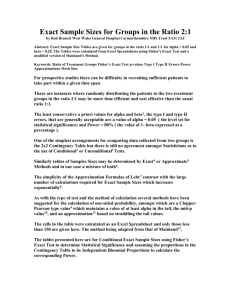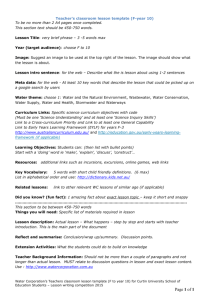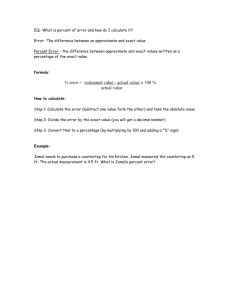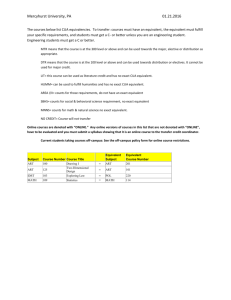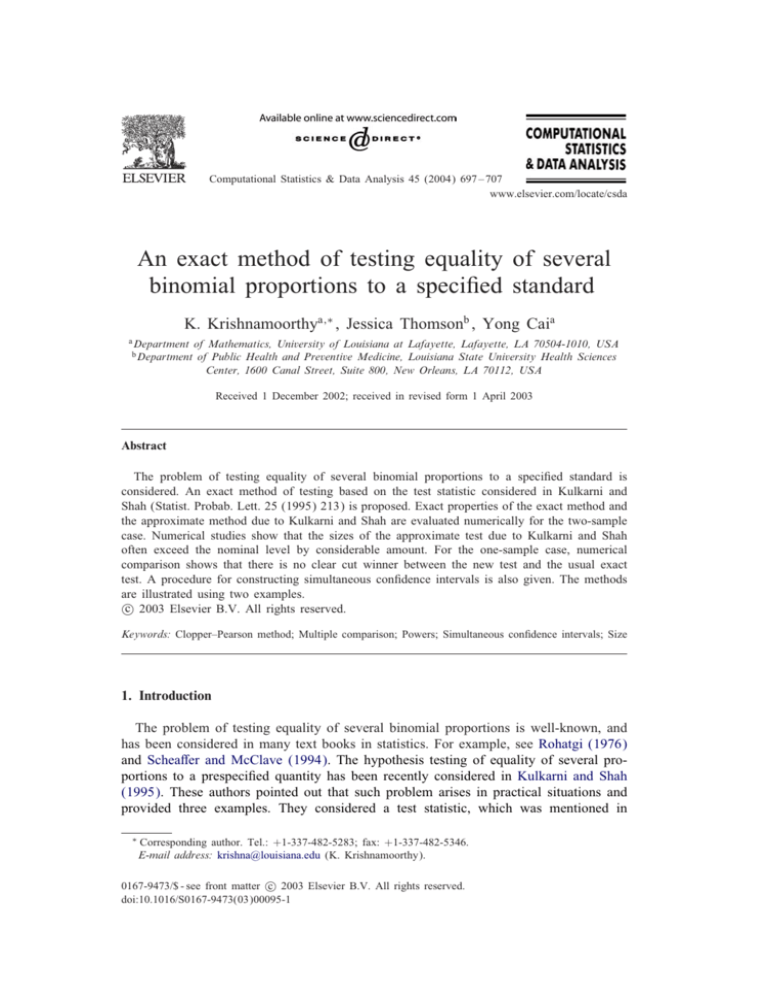
Computational Statistics & Data Analysis 45 (2004) 697 – 707
www.elsevier.com/locate/csda
An exact method of testing equality of several
binomial proportions to a speci)ed standard
K. Krishnamoorthya;∗ , Jessica Thomsonb , Yong Caia
a Department
b Department
of Mathematics, University of Louisiana at Lafayette, Lafayette, LA 70504-1010, USA
of Public Health and Preventive Medicine, Louisiana State University Health Sciences
Center, 1600 Canal Street, Suite 800, New Orleans, LA 70112, USA
Received 1 December 2002; received in revised form 1 April 2003
Abstract
The problem of testing equality of several binomial proportions to a speci)ed standard is
considered. An exact method of testing based on the test statistic considered in Kulkarni and
Shah (Statist. Probab. Lett. 25 (1995) 213) is proposed. Exact properties of the exact method and
the approximate method due to Kulkarni and Shah are evaluated numerically for the two-sample
case. Numerical studies show that the sizes of the approximate test due to Kulkarni and Shah
often exceed the nominal level by considerable amount. For the one-sample case, numerical
comparison shows that there is no clear cut winner between the new test and the usual exact
test. A procedure for constructing simultaneous con)dence intervals is also given. The methods
are illustrated using two examples.
c 2003 Elsevier B.V. All rights reserved.
Keywords: Clopper–Pearson method; Multiple comparison; Powers; Simultaneous con)dence intervals; Size
1. Introduction
The problem of testing equality of several binomial proportions is well-known, and
has been considered in many text books in statistics. For example, see Rohatgi (1976)
and Schea>er and McClave (1994). The hypothesis testing of equality of several proportions to a prespeci)ed quantity has been recently considered in Kulkarni and Shah
(1995). These authors pointed out that such problem arises in practical situations and
provided three examples. They considered a test statistic, which was mentioned in
∗
Corresponding author. Tel.: +1-337-482-5283; fax: +1-337-482-5346.
E-mail address: krishna@louisiana.edu (K. Krishnamoorthy).
c 2003 Elsevier B.V. All rights reserved.
0167-9473/$ - see front matter doi:10.1016/S0167-9473(03)00095-1
698
K. Krishnamoorthy et al. / Computational Statistics & Data Analysis 45 (2004) 697 – 707
Rohatgi (1976), whose null distribution is asymptotically chi-square. Kulkarni and Shah
also derived a non-null distribution, and provided a method for testing hypotheses that
involve one-sided alternatives.
To formulate the present problem, consider m independent binomial random variables
X1 ; : : : ; Xm with Xi ∼ binomial(ni ; pi ); 0 ¡ pi ¡ 1; i = 1; : : : ; m. Let ki be an observed
value of Xi , i = 1; : : : ; m. The hypotheses of interest are
H0 : p1 = · · · = pm = p0
vs:
Ha : pi = p0 for some i:
To test (1.1), Kulkarni and Shah (1995) consider the test statistic
m
(Xi − ni p0 )2
;
TX =
ni p 0 q0
(1.1)
(1.2)
i=1
where q0 = 1 − p0 , whose null distribution is asymptotically chi-square with df = m
(see Rohatgi, 1976). Let ki be an observed value of Xi ; i = 1; : : : ; m, and let Tk be an
observed value of TX . The value of Tk can be computed using TX in (1.2) with Xi
replaced by ki ; i = 1; : : : ; m. The null hypothesis in (1.1) will be rejected whenever the
p-value
P(m2 ¿ Tk ) 6 :
(1.3)
For testing
H0 : p1 = · · · = pm = p0
vs:
Ha : pi ¿ p0 for some i;
Kulkarni and Shah proposed the test statistic
m
(Xi − ni p0 )2+
;
TX+ =
n i p0 q 0
(1.4)
(1.5)
i=1
where x2+ = x2 if x ¿ 0, and 0 otherwise. When ni = n, i = 1; : : : ; m, an approximate
formula to compute the p-value is given by
m
P(Y = i)P(i2 ¿ observed TX+ );
(1.6)
i=1
where Y ∼ binomial(m; ), and = P(X ¿ np0 ), with X ∼ binomial(n; p0 ). These
authors also provide an approximate formula for the p-value when the ni ’s are not
equal.
In this article, using the fact that the common proportion under the H0 is known, we
point out an exact method for computing the p-value of the test based on the statistic
TX in (1.2). The test method, given in the following section, is exact in the sense that
the size of the test never exceeds the nominal level. We also show that this method
is applicable for one-sided alternatives as well. In Section 3, we compared the usual
test and the new test for the one-sample case, and found no clear cut winner between
them. In Section 4, we evaluated exact powers and sizes of the proposed tests and the
asymptotic tests given above for the two-sample case. Our numerical study shows that
the sizes of the approximate tests exceed the nominal level by a considerable amount. In
particular, the sizes of the approximate test based on (1.6) (for one-sided alternatives)
K. Krishnamoorthy et al. / Computational Statistics & Data Analysis 45 (2004) 697 – 707
699
exceed the nominal level signi)cantly even when the sample sizes are large. In Section
5, we outline a method of constructing simultaneous con)dence intervals based on the
Clopper–Pearson (1934) method for constructing one-sample con)dence interval. The
methods are illustrated using two examples in Section 6.
2. The proposed testing method
The probability mass function of a binomial(n; p) random variable is given by
n
f(x; n; p) =
px (1 − p)n−x ; x = 0; 1; : : : ; n:
(2.1)
x
Note that under the null hypothesis in (1.1), the common proportion p0 is known, and
hence f(xi ; ni ; p0 ), is known for i =1; : : : ; m. Since X1 ; : : : ; Xm are independent, the joint
probability mass function is given by P(X1 = x1 ; : : : ; Xm = xm ) = f(x1 ; n1 ; p0 ) × · · · ×
f(xm ; nm ; p0 ). Using this fact, and an indicator function I (:), the p-value of the test
statistic TX can be computed. Indeed, for a given observed value Tk , the p-value can
be expressed as
P(TX ¿ Tk |H0 ) = EX1 ;:::;Xm I (TX ¿ Tk |H0 )
=
=
n1
···
nm
P(X1 = x1 ; : : : ; Xm = xm |H0 )I (Tx ¿ Tk )
x1 =0
xm =0
n1
nm
m
xm =0
i=1
···
x1 =0
f(xi ; ni ; p0 )I (Tx ¿ Tk ) ;
(2.2)
where EX1 ;:::;Xm denotes the expectation under the joint distribution of X1 ; : : : ; Xm . The
null hypothesis in (1.1) will be rejected whenever the p-value in (2.2) is less than or
equal to .
Remark 2.1. At the outset one may think of the Fisher’s exact test (the conditional
test) for testing (1.1). We, however, note that the Fisher’s method often tests the
equality of proportions and not the equality of proportions to the speci)ed standard.
Hence, the Fisher’s method is not applicable to the present problem.
The p-value for testing one-sided alternatives can be computed similarly. For testing
(1.4), the p-value is given by
m
nm
n1
+
+
+
+
P(TX ¿ Tk |H0 ) =
···
f(xi ; ni ; p0 )I (Tx ¿ Tk ) :
(2.3)
x1 =0
Tk+
xm =0
i=1
The value of
can be computed using the expression for TX+ in (1.5) with Xi replaced
by ki ; i = 1; : : : ; m.
For smaller m, say m 6 5, the p-values in (2.2) and (2.3) can be computed in a
straightforward manner using softwares such as SAS and Fortran with IMSL libraries. A
faster computational approach is to compute each probability mass function at its mode
700
K. Krishnamoorthy et al. / Computational Statistics & Data Analysis 45 (2004) 697 – 707
(integer part of ni p0 ), and then to compute other terms using forward and backward
recurrence relations for binomial probabilities. For moderate m one can use Monte
Carlo method, as shown in the following algorithm, to compute the p-value.
Algorithm 1. For a given p0 , m, ni ’s and ki ’s:
2
m
i p0 )
Compute Tk = i=1 (kin−n
i p0 q0
Generate Xij ∼ binomial(ni ; p0 ); i = 1; : : : ; k; j = 1; : : : ; N
k (X −n p )2
For each j, compute TXj = i=1 ijni p0iq00 ; j = 1; : : : ; N .
The proportion of TXj ’s that are greater than or equal to Tk is a Monte Carlo estimate
of the p-value in (2.2).
The p-value in (2.3) can be computed similarly. If Algorithm
1 is used with N =
100; 000, then the maximum simulation error will be 2 × 0:5(1 − 0:5)=100; 000 =
0:0032. Thus, the Monte Carlo results based on 100,000 runs maybe quite satisfactory,
for practical applications.
3. Size and power properties for the one-sample case
For the one-sample case, the proposed test is di>erent from the usual one, and hence
it is of interest to compare them with respect to size and power. For an observed value
k1 of n1 , the usual exact test rejects the H0 in (1.1), whenever the p-value
2 min{P(X1 ¿ k1 |n1 ; p0 ); P(X1 6 k1 |n1 ; p0 )} 6 :
The sizes and powers of both tests can be computed using the expression
n1
f(k1 ; n1 ; p1 )I ((p-value | n1 ; p0 ) 6 ) :
k1 =0
Note that when p1 = p0 , the above expression gives exact size. We computed the sizes
of both exact tests and presented them in Table 1. We observe from the table values
that the sizes of the new test are, in most cases, closer to the nominal level than are
the sizes of the usual test. Comparison of powers in Table 2 indicates that there is
no clear cut winner between these two exact tests. We observe that the test that has
larger size has more power than the other test. For example, we see in Table 1 that
the sizes of the new test are greater than or equal to those of the usual test, and in
this case the new test seems to be more powerful than the usual one (see Table 2,
p0 = 0:1). On the other hand, the usual test has better size property than the new test
for p1 = p0 = 0:25; n1 = 14 and 20. In these situations, the usual test appears to be
more powerful than the new test (see Table 2, p0 = 0:25; n1 = 14 and 20).
4. Size and power properties for the two-sample case
For a given n1 ; n2 ; p1 ; p2 ; p0 , recall that the power of a test is the probability of
rejecting H0 when Ha is true. The exact power of the approximate test in (1.3) can be
K. Krishnamoorthy et al. / Computational Statistics & Data Analysis 45 (2004) 697 – 707
701
Table 1
Exact sizes of the usual test (1) and the new test (2) when = 0:05
p = p0
n = 10
0.05
0.10
0.15
0.20
0.25
0.30
0.35
0.40
0.45
0.50
14
20
27
50
1
2
1
2
1
2
1
2
1
2
0.012
0.013
0.010
0.006
0.020
0.011
0.018
0.018
0.028
0.021
0.012
0.013
0.050
0.033
0.020
0.011
0.039
0.018
0.007
0.021
0.004
0.009
0.012
0.012
0.028
0.015
0.045
0.026
0.028
0.013
0.030
0.044
0.047
0.044
0.010
0.038
0.045
0.026
0.028
0.013
0.016
0.011
0.022
0.022
0.038
0.025
0.032
0.037
0.040
0.041
0.016
0.043
0.022
0.044
0.017
0.025
0.032
0.037
0.040
0.041
0.010
0.015
0.026
0.030
0.042
0.034
0.041
0.029
0.032
0.019
0.044
0.047
0.026
0.049
0.042
0.034
0.041
0.049
0.032
0.019
0.012
0.030
0.027
0.033
0.033
0.031
0.037
0.029
0.045
0.033
0.038
0.030
0.044
0.049
0.048
0.043
0.037
0.029
0.045
0.033
Table 2
Exact powers of the usual test (1) and the new test (2) when H0 : p = p0 vs. Ha : p = p0 and = 0:05
p
n = 10
1
14
20
27
50
2
1
2
1
2
1
2
1
2
p0 = 0:1
0.05
0.001
0.10
0.013
0.15
0.050
0.20
0.121
0.25
0.224
0.30
0.350
0.35
0.486
0.40
0.618
0.45
0.734
0.50
0.828
0.001
0.013
0.050
0.121
0.224
0.350
0.486
0.618
0.734
0.828
0.000
0.009
0.047
0.130
0.258
0.416
0.577
0.721
0.833
0.910
0.004
0.044
0.147
0.302
0.479
0.645
0.780
0.876
0.937
0.971
0.000
0.011
0.067
0.196
0.383
0.584
0.755
0.874
0.945
0.979
0.003
0.043
0.170
0.370
0.585
0.762
0.882
0.949
0.981
0.994
0.000
0.015
0.099
0.287
0.529
0.744
0.885
0.958
0.987
0.997
0.002
0.047
0.210
0.461
0.701
0.864
0.949
0.985
0.996
0.999
0.077
0.030
0.209
0.556
0.836
0.960
0.993
0.999
1.00
1.00
0.077
0.030
0.209
0.556
0.836
0.960
0.993
0.999
1.00
1.00
p0 = 0:25
0.05
0.000
0.10
0.000
0.15
0.001
0.20
0.006
0.25
0.020
0.30
0.047
0.35
0.095
0.40
0.166
0.45
0.262
0.50
0.377
0.000
0.000
0.001
0.006
0.020
0.047
0.095
0.166
0.262
0.377
0.488
0.229
0.103
0.046
0.028
0.038
0.078
0.151
0.259
0.395
0.000
0.000
0.000
0.002
0.010
0.031
0.075
0.150
0.259
0.395
0.736
0.392
0.176
0.072
0.038
0.056
0.124
0.245
0.409
0.588
0.358
0.122
0.039
0.014
0.017
0.049
0.122
0.245
0.409
0.588
0.850
0.485
0.208
0.075
0.042
0.085
0.203
0.387
0.597
0.779
0.850
0.485
0.208
0.075
0.042
0.085
0.203
0.387
0.597
0.779
0.988
0.770
0.361
0.104
0.033
0.087
0.274
0.554
0.803
0.941
0.988
0.770
0.361
0.106
0.048
0.143
0.379
0.664
0.873
0.968
702
K. Krishnamoorthy et al. / Computational Statistics & Data Analysis 45 (2004) 697 – 707
expressed as
P(22 ¿ Tk |Ha ) =
n1 n2
f(k1 ; n1 ; p1 )f(k2 ; n2 ; p2 )I (P(22 ¿ Tk |H0 ) 6 ):
(4.1)
k1 =0 k2 =0
The power of test (1.6) for one-sided alternative can be expressed similarly.
The power of the exact test in (2.2) can be written as
n1 n2
f(k1 ; n1 ; p1 )f(k2 ; n2 ; p2 )I
k1 =0 k2 =0
×
n1 n2
f(x1 ; n1 ; p0 )f(x2 ; n2 ; p0 )I (Tx ¿ Tk ) 6 :
(4.2)
x1 =0 x2 =0
The power of the exact test in (2.3) for testing one-sided alternatives can be computed
using (4.2) with (Tx ; Tk ) replaced by (Tx+ ; Tk+ ).
Notice that expressions (4.1) and (4.2) give sizes of the tests when p1 = p2 = p0 .
It is clear from the above expressions that the power functions can be extended to the
case of m ¿ 3 in a straightforward manner. Even though the power functions can be
written for any m, they are computationally intensive when m ¿ 3. In these cases, we
again recommend Monte Carlo method similar to the one presented in Algorithm 1.
The sizes of the approximate test and the exact test are computed using (4.1) and
(4.2) for the case of m=2, and various values of sample sizes and parameter con)gurations. The sizes are plotted in Figs. 1(a) – (f) for testing two-sided hypotheses in (1.1),
and in Figs. 2(a) – (f) for one-sided alternatives in (1.4). It is clear from Figs. 1(a) – (e)
that the sizes of the approximate test based on (1.3) are larger than the nominal level
0.05 when the proportions are small. When the alternatives are one-sided, the sizes of
the approximate test exceed the nominal level considerably even for moderate samples
(see Figs. 2(a) – (e)). The sizes of the exact tests are either below or very close to the
nominal level 0.05 for all the cases considered.
To understand the power properties of the tests, we plotted the powers of the approximate test and the exact test in Fig. 3. Both tests satisfy some natural requirements
of a test. In particular, we see from Figs. 3(a) – (d) that the power of the tests increases
as the sample size increases, and/or when the di>erence between the true parameter
and the speci)ed parameter increases. The power of the approximate test is inMated
(see Fig. 3(a)) because of its larger sizes.
5. Multiple comparison
If the null hypothesis in (1.1) is rejected, then it is important to identify the population proportions which caused the rejection. This can be done by examining the simultaneous con)dence intervals for p1 ; : : : ; pm . Toward this end, we describe the Clopper
and Pearson’s (1934) con)dence interval (see Johnson and Kotz (1969, p. 58)) for the
one-sample case. Let Beta(c; a; b) denote the cth quantile of a beta distribution with
K. Krishnamoorthy et al. / Computational Statistics & Data Analysis 45 (2004) 697 – 707
703
Fig. 1. Exact sizes of the two-sided tests as a function of the proportions at the nominal level = 0:05; ‘App.
Test’ is the test based on (1.3), ‘Exact Test’ is the test based on (2.2): (a) n1 = n2 = 10, (b) n1 = n2 = 20,
(c) n1 = n2 = 30, (d) n1 = 10; n2 = 5, (e) n1 = 20; n2 = 10, and (f) n1 = 30; n2 = 20.
shape parameters a and b. Then, for a given 0 ¡ c ¡ 1, the Clopper–Pearson 1 − c
con)dence interval for pi based only on (ki ; ni ) is given by
(Li = Beta(c=2; ki ; ni − ki + 1); Ui = Beta(1 − c=2; ki + 1; ni − ki ))
(Li ; Ui ) = (0; (1 − c)1=ni ); if ki = 0;
and
(Li ; Ui ) = (c1=ni ; 1); if ki = ni :
(5.1)
704
K. Krishnamoorthy et al. / Computational Statistics & Data Analysis 45 (2004) 697 – 707
Fig. 2. Exact sizes of the one-sided tests as a function of the proportions at the nominal level = 0:05; ‘App.
Test’ is the test based on (1.6), ‘Exact Test’ is the test based on (2.3): (a) n1 = n2 = 10, (b) n1 = n2 = 20,
(c) n1 = n2 = 30, (d) n1 = 10; n2 = 5, (e) n1 = 20; n2 = 10, and (f) n1 = 30; n2 = 20.
The coverage probability of this con)dence interval is at least 1−c for any sample size.
It should be noted that it is not possible to construct an exact con)dence interval (that
is, the coverage probability is equal to the con)dence level) because of the discreteness
of the distribution. By choosing c = 1 − (1 − )1=m , we see that (Li ; Ui ) contains pi
with probability at least (1 − )1=m , and hence
P(pi ∈ (Li ; Ui ); i = 1; : : : ; m) ¿ 1 − :
(5.2)
K. Krishnamoorthy et al. / Computational Statistics & Data Analysis 45 (2004) 697 – 707
705
Fig. 3. Actual power of the tests as a function of the sample sizes at the nominal level = 0:05; A=the
approximate test based on (1.3); E = the exact test based on (2.2): (a) p0 = p1 = 0:05, (b) p0 = p1 = 0:85,
(c) p0 = p1 = 0:35, and (d) p0 = p1 = 0:65; n1 = 5.
Thus, if p0 ∈ (Lj ; Uj ); j=1; : : : ; m1 6 m, then we conclude that the pj ’s are signi)cantly
di>erent from p0 at the level .
One-sided intervals for p1 ; : : : ; pm can also be constructed similarly. Suppose we want
to )nd the population proportions that are greater than p0 . Then, taking c=1−(1−)1=m ,
we see that
P(pi ∈ (Li ; 1); i = 1; : : : ; m) ¿ 1 − ;
(5.3)
where Li = Beta(c; ki ; ni − ki + 1); Li = 0 if ki = 0 and Li = c1=ni if ki = ni ; i = 1; : : : ; m.
If Lj ¿ p0 , j = 1; : : : ; m1 6 m, then we conclude that the corresponding pj ’s exceed p0
at the level .
Simultaneous upper limits can be constructed similarly. Taking c as above in the
construction of lower limits, we see that
P(pi ∈ (0; Ui ); i = 1; : : : ; m) ¿ 1 − ;
where Ui = Beta(1 − c; ki + 1; ni − ki ); Ui = 1 if ki = ni and Ui = (1 − c)1=ni if ki = 0.
706
K. Krishnamoorthy et al. / Computational Statistics & Data Analysis 45 (2004) 697 – 707
6. Examples
We shall now illustrate the methods using the two examples given in Kulkarni and
Shah (1995).
Example 1. In this example, we are interested in estimating the percentage of gopher
tortoise active burrows. The data were obtained by experience judgement and camera
judgement during the summers of 1987–1989. The data along with 95% simultaneous
con)dence intervals are given in the following table.
Judgement type and period
Experience judgement
Summer 1987 and 1988
Experience judgement
Summer 1989
Camera judgement
Summer 1989
ni
ki
90% CI
95% CI
81
59
(0.6097, 0.8274)
(0.5945, 0.8380)
151
107
(0.6230, 0.7846)
(0.6120, 0.7933)
114
48
(0.3226, 0.5243)
(0.3109, 0.5371)
The established percentage of active burrows is 62%, and hence we want to test
H0 : p1 = p2 = p3 = 0:62 vs. Ha : pi = 0:62 for some i. Both the approximate test in
(1.3) and the exact test in (2.2) produced p-values very close to 0. To )nd out the
proportions that are not equal to p0 = 0:62, we constructed 90% and 95% simultaneous
con)dence intervals for p1 ; p2 ; p3 , and presented in the above table. These simultaneous con)dence intervals are constructed using (5.1) with c = 1 − (0:95)1=3 = 0:01695.
Examining the 95% con)dence intervals, we see that the third interval does not contain
p0 = 0:62, and hence we conclude that p3 is di>erent from 0.62 at the signi)cance
level of 0.05.
Example 2. A manufacturing )rm produces bolts using six di>erent processes. The
)rm inspects the bolts for defects periodically. The production process will be stopped
for correction if there is an indication that at least one of the machines has started
production higher than 5% of defective bolts. The data set along with 90% simultaneous
lower limits for the proportions are given in the following table.
Machine
ki
ni
90% Lower limits
95% Lower limits
1
2
3
4
5
6
11
6
2
8
8
4
100
100
100
100
100
100
0.05317
0.02054
0.00200
0.03283
0.03283
0.00984
0.04791
0.01752
0.00137
0.02884
0.02884
0.00794
The hypotheses of interest are
H0 : p1 = · · · = p6 = 0:05
vs:
Ha : pi ¿ 0:05 for some i:
K. Krishnamoorthy et al. / Computational Statistics & Data Analysis 45 (2004) 697 – 707
707
Kulkarni and Shah’s (1995) approximate method produced a p-value of 0.008 whereas
the Monte Carlo method in Algorithm 1 produced a p-value of 0.029. Kulkarni and
Shah also reported the p-value for two-sided alternative, which is 0.036; our Monte
Carlo method also yielded 0.036. It is clear that Monte Carlo method p-values for
one-sided alternatives and two-sided alternatives are in agreement, whereas those of
approximate methods are not. We also provided 90% simultaneous con)dence intervals
and 95% simultaneous con)dence intervals for p1 ; : : : ; p6 using (5.2). Based on these
intervals, we can conclude, at the level 0.10, that machine 1 produces defective bolts
at a rate higher than 5%.
Acknowledgements
The authors are thankful to a referee and an associate editor for their comments.
References
Clopper, C.J., Pearson’s, E.S., 1934. The use of con)dence or )ducial limits illustrated in the case of the
binomial. Biometrika 26, 404–413.
Johnson, N.L., Kotz, S., 1969. Discrete Distributions. Wiley, New York, NY.
Kulkarni, P.M., Shah, A.K., 1995. Testing the equality of several binomial proportions to a prespeci)ed
standard. Statist. Probab. Lett. 25, 213–219.
Rohatgi, V.K., 1976. An Introduction to Probability Theory and Mathematical Statistics. Wiley, New York.
Schea>er, R.L., McClave, J.T., 1994. Probability and Statistics for Engineers. Duxbury Press, New York.

